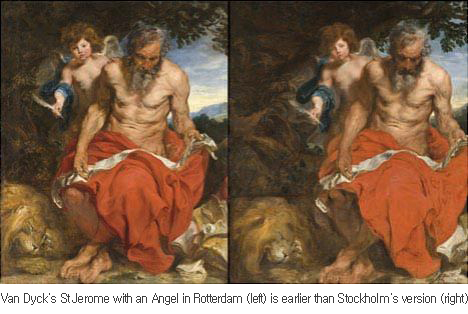 Riddle of the two Van Dycks
Riddle of the two Van Dycks X-radiography and infrared imaging help scholars determine which is the copy
By Emily Sharpe | From issue 209, January 2010
Published online 8 Jan 10 (Conservation)
LONDON. Between 1618 and 1621, two ostensibly identical works entitled St Jerome with an Angel were produced in Van Dyck’s Antwerp studio; one painting now belongs to the Nationalmuseum in Stockholm and the other is on long-term loan to the Museum Boijmans Van Beuningen in Rotterdam. Now after almost 40 years of scholarly debate, new research conducted by the two institutions has finally answered the question as to which came first.
The Stockholm version of the work entered the Swedish royal collection in 1746/47 when it was purchased by King Adolf Frederick. It has been on public view since 1792.
The Rotterdam version, which was originally owned by Rubens, Van Dyck’s mentor, has had a lower profile. The painting remained in private collections and therefore virtually unseen for much of the 19th and 20th centuries, only re-emerging in 1972 when the Willem van der Vorm Foundation loaned the work to the Boijmans. Its reappearance in the 70s immediately sparked a debate among scholars as to which was the original.
In February 2009, after extensive conservation work on both paintings—the Rotterdam version underwent treatment in 2005 and work on the Stockholm painting finished in early 2009—the two works were compared side-by-side for the first time at the Nationalmuseum in Stockholm. There, a team which included Boijmans conservator Annetje Boersma and Lena Dahlén from the Stockholm institution, took paint samples
and examined the works using
x-radiography and infrared imaging. Direct examination showed that the Rotterdam painting was in better condition: the Stockholm work had sustained damage as a result of previous restorations which have abraded the faces of the figures and the folds of St Jerome’s robe.
The results of the scientific analysis revealed several major pentimenti or changes to the Rotterdam work not found in the Stockholm version. For example, x-radiography revealed that St Jerome’s cloak was originally floor length, with only the saint’s feet visible. Van Dyck later decided to change the composition by painting St Jerome’s lower leg over the cloak. Significant changes to the angel were also found.
This evidence, combined with the freer brushstroke on the Rotterdam painting, led the researchers to conclude that it is the original and that the Stockholm work is a copy. Analysis of the paint samples revealed that identical pigments were used for both works, ruling out the possibility that the Stockholm painting could have been an 18th-century copy.
What remains to be seen is how much of the Stockholm piece can be attributed to Van Dyck versus how much was painted by his studio using the Rotterdam work as a model. According to Boijmans curator Friso Lammertse, more research and comparisons of Van Dyck’s early work is needed before this question can be answered. The fact that Van Dyck employed several assistants, and that there are least two versions of his major early works, makes it difficult to assign a work’s complete authorship to the master.
“If you buy an early Van Dyck you should be aware that there is likely to be a second or third version,” says Lammertse, adding: “It’s more about the quality of the piece, rather than simply a matter of which was first.”
The Art Newspaper has learned that the Prado in Madrid is planning an exhibition devoted to the early work of Van Dyck in 2012.
Both works can be seen in the show “Masterpiece and Copy? Anthony van Dyck” on view at the Museum Boijmans Van Beuningen until 14 February. The pieces will then travel to Stockholm’s Nationalmuseum for “Rubens & Van Dyck” (25 February-23 May).
 Riddle of the two Van Dycks
Riddle of the two Van Dycks